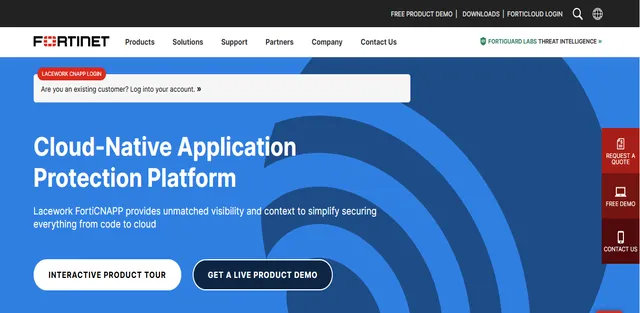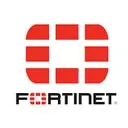
Lacework FortiCNAPP is a Cloud-Native Application Protection Platform (CNAPP) developed by Fortinet, designed to provide comprehensive security for cloud environments. It combines multiple security capabilities, including Cloud Security Posture Management (CSPM), Kubernetes Security (KSPM), Cloud Infrastructure Entitlement Management (CIEM), Cloud Workload Protection Platform (CWPP), policy as code enforcement, application security, infrastructure as code security, and cloud detection and response, along with Fortinet's FortiSOAR and FortiGuard capabilities. It simplifies and strengthens cloud security by offering unmatched visibility and context, helping organizations manage risk, detect and respond to threats quickly, and maintain compliance across complex, multi-cloud environments.
What is Lacework FortiCNAPP?
Lacework FortiCNAPP is a comprehensive CNAPP that secures cloud environments, combining tools like Cloud Security Posture Management (CSPM) and Cloud Detection and Response (CDR). It simplifies security by offering visibility and context, helping manage risks and detect threats quickly.
Key Features of Lacework FortiCNAPP
Lacework FortiCNAPP offers a wide range of features that make it a robust CNAPP solution.
- Unmatched Visibility: Gain comprehensive insights into cloud assets, configurations, and activities, enabling proactive security measures.
- Unified Cloud Security: Consolidate fragmented tools into a single platform.
- Zero-Day Threat Detection: Continuously monitor workloads and detect unusual behavior without the need for rules.
- Anomaly Detection: Detecting unusual behavior and reducing alert noise.
- Risk Prioritization: Visualize complex relationships between entities, risks, and threats.
- Cloud Identity Risk Management: Provide visibility into all users, resources, groups, and roles across multiple cloud service providers.
- Continuous Compliance: Automatically map cloud assets to compliance frameworks (e.g., PCI DSS, HIPAA, SOC 2, ISO 27001) and continuously assess posture to ensure regulatory compliance.
- Cloud-Native Application Protection: Secure applications from code to cloud with features like Static Application Security Testing (SAST), Software Composition Analysis (SCA), Software Bill of Materials (SBOM), and Infrastructure as Code (IaC) security.
- Cloud Detection and Response (CDR): Quickly detect and respond to active threats with real-time monitoring and automated remediation.
- Vulnerability Assessment: Reduce vulnerability noise by contextualizing risks within the environment, focusing on exploitable vulnerabilities.
These features are designed to simplify and strengthen cloud security, making Lacework FortiCNAPP a comprehensive solution for modern cloud-native environments.
Use Cases of Lacework FortiCNAPP
Lacework FortiCNAPP is versatile and caters to various use cases, including:
- Cloud Security for Enterprises: Large organizations can secure their cloud infrastructure, applications, and data across multiple cloud service providers (AWS, Azure, Google Cloud).
- DevOps and Development Teams: Developers can integrate Lacework FortiCNAPP into CI/CD pipelines to shift security left, identifying and fixing vulnerabilities early in the development process.
- Security Operations Centers (SOCs): SOC teams can use it for real-time threat detection, investigation, and response, reducing the mean time to detect and respond (MTTD/MTTR).
- Compliance and Audit Teams: Compliance and audit teams can ensure continuous compliance.
- Cloud Service Providers (CSPs): CSPs can enhance their security offerings by integrating Lacework FortiCNAPP into their services.
Pros and Cons of Lacework FortiCNAPP
Pros:
- Offers comprehensive CNAPP solution combining multiple security capabilities.
- AI-driven and automated features reduce manual effort and improve efficiency.
- Provides unmatched visibility and context for cloud security.
- Simplifies compliance management with continuous assessment and reporting.
- Integrates seamlessly with Fortinet's Security Fabric and other tools.
Cons:
- Require significant initial setup and configuration for full utilization.
- Dependence on AI and machine learning might raise concerns about false positives or negatives.
- CNAPP solutions can be costly.
- Not be as flexible for organizations with highly customized security workflows.
 Lacework FortiCNAPP Reviews & Ratings: See What Users and Experts Are Saying
Lacework FortiCNAPP Reviews & Ratings: See What Users and Experts Are Saying
 Lacework FortiCNAPP FAQ: Learn How to Use It, Troubleshoot Issues, and More
Lacework FortiCNAPP FAQ: Learn How to Use It, Troubleshoot Issues, and More
FortiSOAR for orchestration and FortiGuard for threat intelligence.
Lacework FortiCNAPP is the result of Fortinet's acquisition of Lacework, combining Lacework's CNAPP capabilities with Fortinet's security solutions like FortiSOAR and FortiGuard.
It integrates with Fortinet's Security Fabric, including FortiSOAR for orchestration, automation, and response, and FortiGuard for threat intelligence.
Yes, it supports multiple cloud service providers, including AWS, Azure, and Google Cloud.
It offers both agent-based and agentless deployment options, providing flexibility based on organizational needs.
It provides continuous compliance monitoring, mapping cloud assets to various compliance frameworks, and offering detailed reporting.
Recent updates include enhancements to the Compliance Dashboard, new features like Smart Fix for Code Security, and improved composite alerts for early detection of active attacks.














